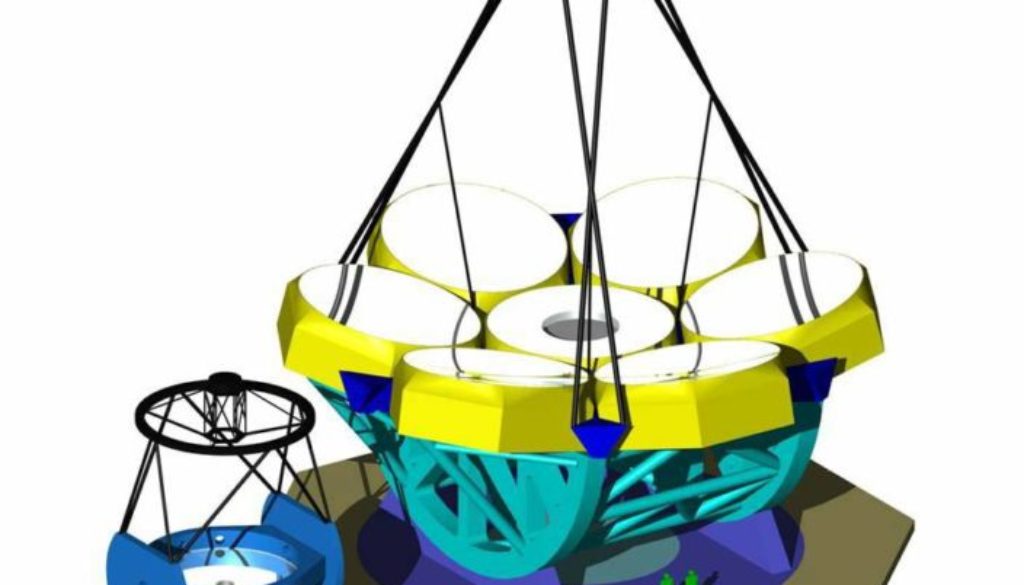First Mirror for Giant Telescope to be Cast
The Carnegie Observatories of the Carnegie Institution and the University of Arizona, Steward Observatory Mirror Lab, have signed an agreement to produce the first mirror for the Giant Magellan Telescope (GMT) — the first telescope of the next-generation of extremely large ground-based telescopes (ELT) to begin mirror production. Texas A&M University is a partner in the ambitious project.
The telescope will have a diameter of about 70 feet — about as wide as the Christmas tree in Rockefeller Center, New York, is tall.
“This agreement is historic for the future of astronomy,” stated Dr. Richard Meserve, president of the Carnegie Institution. “It is the first of many milestones that we and our partners look forward to -both in constructing an enormous ground-based telescope and in the scientific discoveries that will result. Everyone in the eight-member GMT consortium is extremely excited by this step.”
The eight-member consortium includes the Carnegie Observatories, Harvard University, Smithsonian Astrophysical Observatory, University of Arizona, University of Michigan, Massachusetts Institute of Technology, University of Texas, Austin, and Texas A&M.
The GMT, slated for completion in 2016 at Carnegie’s Las Campanas Observatory in Chile, will have 10 times the resolution of the Hubble Space Telescope. With its powerful resolution and enormous collecting area, the GMT will be able to probe the secrets of planets that have formed around other stars in the Milky Way, peer back in time toward the Big Bang with unprecedented clarity, delve into the nature of dark matter and dark energy, and explore the formation of black holes — the most important questions in astronomy today.
“This is an especially exciting time for Texas A&M and astronomy,” said Edward Fry, professor and head of the Department of Physics. “It marks the start of the construction of a new generation telescope that will be ‘the’ telescope of the next decade. I am especially pleased that Texas A&M is a major partner in this project, which will result in a telescope that will play a major role in expanding our understanding of the cosmos and of our place in it.”
Texas A&M’s involvement in the GMT was made possible by a $1.25 million gift from real estate developer and petroleum engineer George Mitchell, a 1940 Texas A&M graduate. Other Mitchell gifts to the Department of Physics have funded endowed chairs as well as the Mitchell Institute for Fundamental Physics, which annually attracts eminent experts such as Cambridge University physicist Stephen Hawking and other world-class researchers to Texas A&M.
“The Giant Magellan Telescope will allow an unprecedented view of extrasolar planets as well as a window out to the largest scales and back to the earliest moments of the universe,” adds Wendy Freedman, director of the Carnegie Observatories. ” We plan to complete the GMT so that it will work in tandem with the future generation of planned ground- and space-based telescopes.
“The real distinction of the GMT, however, is that it is building on a heritage of successful technology developed for the twin 6.5-meter Magellan telescopes at Las Campanas. Their performance has far exceeded our expectations.”
The mirrors for the GMT will be made using the existing infrastructure at Steward that made the 6.5-meter Magellan mirrors and the 8.4-meter Large Binocular Telescope mirrors on Mount Graham. The new telescope will be composed of seven, 8.4-meter primary mirrors, arranged in a floral pattern to produce a telescope with a 21.4-meter aperture. One spare off-axis mirror will also be made. Seven of the eight mirrors will be off-axis and require new techniques in casting and polishing. The first off-axis mirror will be cast this coming summer (2005) to address the new challenges.
Detailed information about the design of the GMT and the science that it will perform is located at http://www.gmto.org/.
-aTm-
Contact: Shana K. Hutchins, (979) 862-1237 or shutchins@science.tamu.edu
The post First Mirror for Giant Telescope to be Cast appeared first on Texas A&M College of Science.
